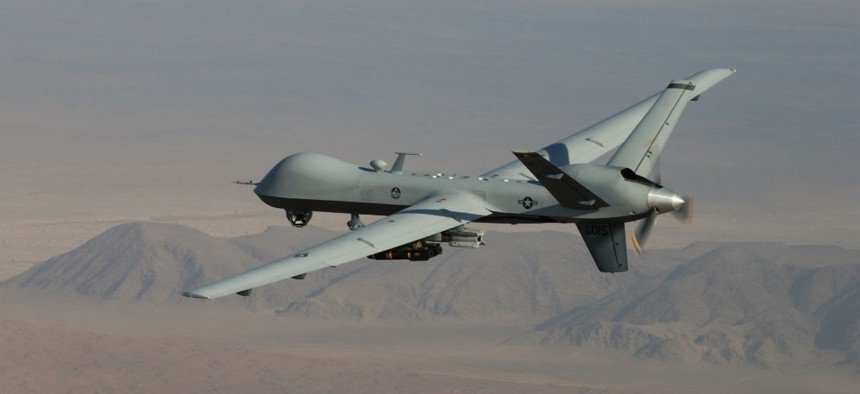Reaper to get universal weapons interface
A new universal weapons interface will allow the Reaper to more quickly integrate new weapons as they emerge. Open mission systems and open architecture are essential to this effort.
The Air Force is in the early phases of adding a new universal weapons interface to the Reaper drone platform, a large 66-foot unmanned system able to conduct aerial surveillance and weapons attacks in key areas across the globe.
The Air Force Military Deputy for Acquisition said in an interview last year that the service has begun the process of adding new weapons to the Reaper, an effort which will likely involve engineering a universal weapons interface.
“We are looking at what kind of weapons do we need to integrate in. We're looking at anything that is in our inventory, including the small diameter bomb. We're working to get universal armament interface with an open mission systems architecture,” Lt. Gen. Arnold Bunch said.
A universal interface built on open mission systems architecture would allow the Reaper to more quickly integrate new weapons technology as it emerges and efficiently swap or replace bombs on the drone, Bunch explained.
“If I can design to that interface, then it costs me less money and takes me less time to integrate a new weapon. I don’t want to go in and open up the software of the airplane. As long as I get the interface right, I can integrate that new weapon much sooner,” he added.
The Reaper currently fires the AGM-114 Hellfire missile, a 500-pound laser-guided weapon called the GBU-12 Paveway II, and Joint Direct Attack Munitions or JDAMs which are free-fall bombs engineered with a GPS and Inertial Navigation Systems guidance kit, Air Force acquisition officials told Scout Warrior. JDAM technology allows the weapons to drop in adverse weather conditions and pinpoint targets with “smart” accuracy.
There are many potential advantages to adding to the arsenal of weapons able to fire from the Reaper. These include an ability to strike smaller targets, mobile targets or terrorists on-the-move in small trucks.
Drone attacks from farther distances could reduce risk to the platform and help strikes against Al Qaeda or ISIS targets better achieve an element of surprise. Also, at some point in the future it may be possible to arm the Reaper for air-to-air engagements as well.
One new possibility for the Reaper drone could be the addition of the GBU-39B or Small Diameter Bomb, Bunch said.
The Small Diameter Bomb uses a smart weapons carrier able to include four 250-pound bombs with a range of 40 nautical miles. The
bomb’s small size reduces collateral damage and would allow the Reaper to achieve more attack strikes per mission, Air Force officials said.
The Small Diameter Bomb, which can strike single or multiple targets, uses GPS precision. It is currently fired from the F-15E, F-16, F-117, B-1, B-2, F-22 and F-35, Air Force officials stated.
The Air Force currently operates 104 Reaper drones and has recently begun configuring the platform with additional fuel tanks to increase range. The Reaper Extended Range, or ER as it’s called, is intended to substantially increase and build upon the current 4,000-pound fuel capacity of the drone with a range of 1,150 miles.
The upgrades to Reaper, would add two 1,350-pound fuel tanks engineered to increase the drones endurance from 16 hours to more than 22 hours, service officials said.
----This Story Was Also Published by Scout Warrior ----




